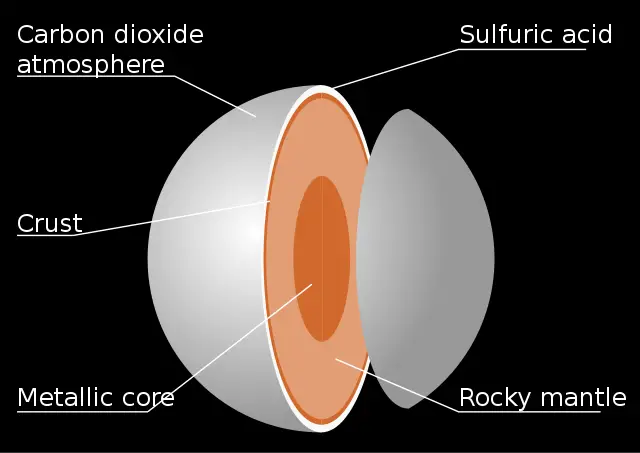There are so many interesting facts about Venus that I thought I’d put together a list of 26 to share with you. So, whether you’re a backyard enthusiast of space or just curious about our neighboring planet, keep reading to learn some cool and surprising facts about Venus!

When you look through your telescope at Venus, you may be surprised to learn that it is not just a bright disc in the sky. Here are some interesting facts about Venus that you may not know:
- Venus is the second planet from the sun and is the brightest natural object in the sky after the Sun and the Moon.
- Venus rotates in the opposite direction of most planets, making its day longer than its year. A day on Venus is 243 Earth days, while a year is only 225 Earth days.
- Venus has a thick atmosphere that is mostly made up of carbon dioxide. This atmosphere traps heat, making the surface of Venus hotter than Mercury, which is closer to the sun.
- The surface of Venus is covered in craters, mountains, and volcanoes. However, due to the thick atmosphere, it is difficult to see these features from Earth.
- Venus is so bright because it reflects a lot of sunlight. In fact, it reflects about 70% of the sunlight that hits it, which is more than any other planet in our solar system.
- Venus is sometimes called the “morning star” or the “evening star” because it is visible when the the sky is lit just before sunrise or just after sunset.
- Venus is often used as a reference point for astronomers because it is so bright and easy to spot. It can help you find other stars and constellations in the sky.
- Venus’s atmosphere contains clouds of sulfuric acid, which reflect so much sunlight that they can actually make Venus appear brighter than Jupiter or Saturn, which are much larger planets.
- Venus has no moons or rings – unlike Jupiter or Saturn.
- Of all the solar system planets, Venus has the hottest surface temperature of any, with temperatures reaching up to 864 degrees Fahrenheit (462 degrees Celsius).
- One interesting feature of Venus is its lack of a magnetic field, which means that it is not protected from the solar wind like Earth is. This may be one reason why the planet has lost much of its water over time.
- The atmosphere of Venus has been studied extensively by scientists all over the world and they’ve found that there are few ways for water molecules or any other substances like oxygen to be present in the atmosphere.
- Venus’ dense atmosphere exerts a pressure 92 times greater than Earth’s atmosphere.
- Venus is often referred to as Earth’s “sister planet” due to its similar size and composition, but the extreme conditions on Venus make it inhospitable to life as we know it.
- Venus has been visited by several spacecraft, including the Soviet Venera missions and NASA’s Magellan spacecraft, which mapped the planet’s surface in detail.
- Venus has been the subject of many scientific studies, including research into its greenhouse effect and the possibility of using Venus as a future target for human exploration and colonization.
- Venus has a retrograde rotation, which means that it rotates in the opposite direction to the other planets in the solar system.
- Venus’ thick layer of clouds, mainly of sulfuric acid, reflect much of the sunlight that hits them, giving Venus its bright appearance.

- Venus has a highly elliptical orbit, which means that its distance from the Sun varies greatly over time. At its closest approach, Venus is about 25 million miles (40 million kilometers) from Earth.
- Venus exhibits a phenomenon known as “transit,” in which it passes in front of the Sun as seen from Earth. These transits occur in pairs, with the last one occurring in 2012 and the next one not expected until 2117.
- Venus has a weak magnetic field, which is thought to be generated by electrical currents in its atmosphere rather than by a dynamo in its core.
- Venus has been the subject of numerous scientific missions, including the European Space Agency’s Venus Express and the Japanese Aerospace Exploration Agency’s Akatsuki spacecraft.
- Venus has a unique atmospheric feature known as the “super-rotation,” in which the atmosphere rotates much faster than the planet itself. This causes winds to reach speeds of up to 220 miles per hour (360 kilometers per hour) at the planet’s equator.
- Venus is known to have active volcanoes, although they are not currently erupting. The planet’s volcanic activity is thought to be responsible for much of the carbon dioxide in its atmosphere.
- Venus has been observed to exhibit a phenomenon known as “ashen light,” in which a faint glow can be seen on the night side of the planet. The cause of this phenomenon is not yet fully understood.
- Venus, as one of the brightest objects in the night sky, known since ancient times, is named after the Roman goddess of love and beauty.
